Resolve Error Code 30068-39 when Installing Microsoft Office
Some Windows users are encountering the Error code 30068-39 whenever they try to install Office365 or Office 2016. This is typically reported to occur on Windows 10 on machines that previously used an older Office version.
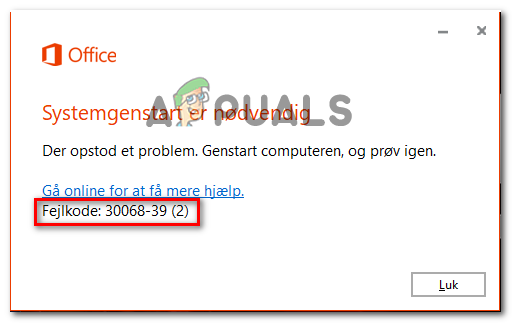
In most cases, the Error Code 30068-39 will occur due to the fact that the new installer is halted by remnant files left behind by old Office installations that were not uninstalled properly. If this scenario is applicable, you can resolve the issue easily by using the scrub utility provided by Microsoft to remove any traces of your old Office installation.
It’s also possible that the installation of the Office suite fails due to the fact that the service that should assist the installer executable (Microsoft Office Click-to-Run) is disabled or prevented from functioning conventionally. In this case, the fix consists of forcing that service to start and ensuring that it’s running at every system startup.
However, in certain circumstances, the problem might be facilitated by some type of system file corruption – this is very likely in case you are encountering installation error with other programs that Microsoft Office. In this case, fixing the system file corruption with utilities like DISM and SFC should allow you to circumvent the error message.
Method 1: Uninstalling other Office installations
As it turns out, one of the common issues that will end up spawning the Error code 30068-39 when the user tries to install Office365 or another Office version is an old installation that is conflicting with the new version.
In most cases, the error occurs due to previous installation files not being properly removed. If this scenario is applicable, you should ensure that you remove any old Office installation files that might contribute to the apparition of this issue.
A lot of users that were encountering this issue have confirmed that the steps below have finally allowed them to fix the issue. Here’s what you need to do in order to uninstall and remove any remnant files that might be triggering the Error code 30068-39:
- Press Windows key + R to open up a Run dialog box. Inside the text box, type ‘appwiz.cpl’ and press Enter to open up the Program and Features window.

Type appwiz.cpl and Press Enter to Open Installed Programs List - Once you’re inside, scroll down through the list of installed applications and locate the old Office installation that might be conflicting with the new version that you’re trying to install. When you see it, right-click on it and choose Uninstall from the context menu.
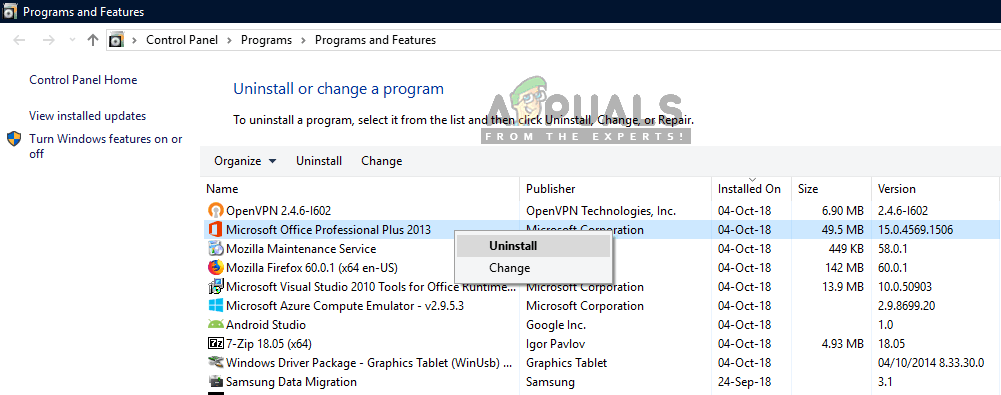
Uninstalling Microsoft Office entries in Control Panel Note: If you can find any entries from your old office installation, skip this step and move directly to step 4.
- Inside the uninstallation screen, follow the prompts to complete the uninstall steps, then restart your computer manually if you’re not prompted to do so.
- After the next startup sequence is complete, access this link (here) from your default browser and scroll down to the Problems while trying to install the Office section. Once you’re there, click on the Download button to download the SetupProd_OffScrub.exe.
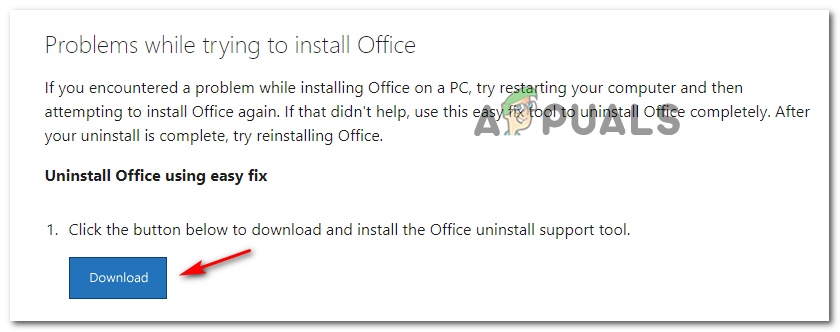
Downloading the SetupProd_OffScrub.exe utility - Once the executable is downloaded, double-click on SetupProd_OffScrub.exe, click on Install and follow the on-screen prompts to remove any Office-related remnant files that might still cause this behavior.
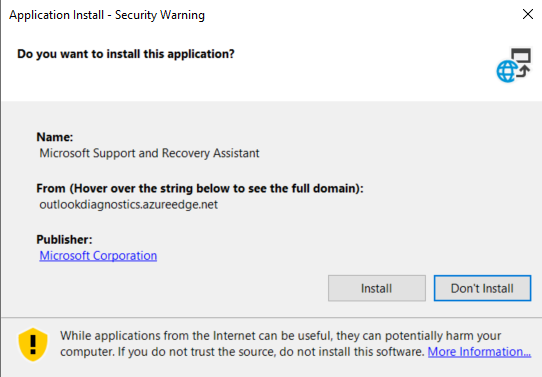
Installing the SetupProd_OffScrub.exe - Once the scrubbing procedure is complete, restart your computer and wait for the next startup to complete.
- Repeat the installation again and see if you’re now able to complete the procedure without seeing the Error code 30068-39.
In case this method wasn’t applicable or you’re still seeing the same error even after scrubbing any remnant files from old office installations, move down to the next potential fix below.
Method 2: Enabling the Click-to-Run service
As it turns out, if your Office installer fails immediately after you open it, this behavior might be caused by you’re system’s inability to run click-to-run installers – This issue is most likely facilitated by a service called Microsoft Office Click-to-Run that ends up being disabled.
Keep in mind that by default, the Microsoft Office Click-to-Run service is enabled by default. But a manual user intervention or some 3rd party app management systems might have ended up disabling it, which will prevent new Office installations.
If this scenario is applicable, you should be able to fix the issue by using the Services utility to force start the Microsoft Office Click-to-Run service.
Here’s a quick guide on how to enable this service and repeat the installation:
- Press Windows key + R to open up a Run dialog box. Next, type ‘services.msc’ inside the text box and press Enter to open up the Services utility.
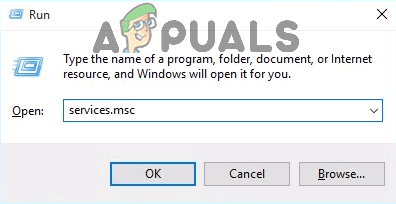
Type “services.msc” into the Run dialog and press Enter Note: When you’re prompted by the UAC (User Account Control), click Yes to grant administrative privileges.
- Once you’re inside the Services screen, select Services (Local) from the left section, then move over to the right section and scroll down through the list of active local services until you locate the Microsoft Office Click-to-Run Service. When you see it, right-click on it and click on Properties from the newly appeared context menu.
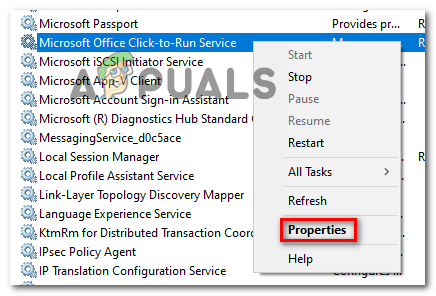
Accessing the Properties screen - Inside the Properties screen of the Microsoft Office Click-to-Run service, select the General tab and see if the Startup type is set to Disabled. If it is, change the Startup type to Automatic using the associated drop-down menu. Next, look below and click on Start in order to force the service to start.
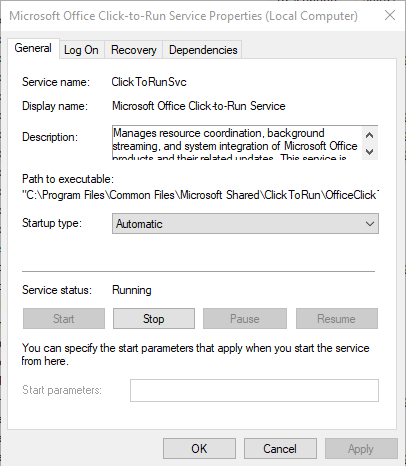
Forcing the Microsoft Office Click-to-Run service to start - After you’ve ensured that the Microsoft Office Click-to-Run service is Enabled and scheduled to launch at every system startup, restart your computer and repeat the installation of the Office version that’s causing the Error code 30068-39.
In case the problem is still not resolved, move down to the next potential fix below.
Method 3: Fixing System File Corruption
If none of the potential fixes above has allowed you to fix the issue, it’s very likely that you’re dealing with some type of system file corruption that ends up inhibiting your operating system’s ability to install new applications.
If Microsoft Office is not the only program that you’re encountering issues with during the installation phase, the only way to get the issue resolved is to resolve the file corruption that’s being responsible for the Error code 30068-39 – The most efficient way of doing this is to use a couple of utilities like (SFC and DISM).
Note: SFC (System File Checker) will use a locally stored cache to replace system corruption with healthy copies while DISM (Deployment Image and Servicing Deployment) uses a sub-component of Windows Update to download and replace corrupted instances.
Since these two utilities operate differently, our advice is to run both in quick succession in (and do a restart in between) in order to maximize your chances of resolving the issue.
Start by performing an SFC scan and do a restart at the end of this procedure to see if the issue is resolved. If the issue persists, move forward with a DISM scan and wait until the procedure is complete before restarting again.
If the two utilities above didn’t fix the issue, you should consider an in-place repair (repair install) procedure or even a clean install if you don’t mind total data loss.





